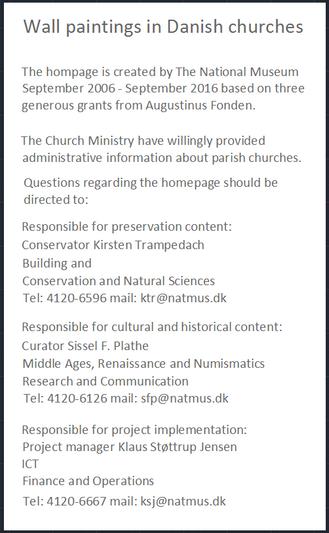About the homepage

Wall paintings are an exceptional pictorial treasure in Denmark, still existing in churches throughout the country. The wall paintings represent a unique art and cultural heritage, which reflects the biblical universe and religious life in the Middle Ages and the centuries thereafter.
The homepage “Wall paintings in Danish churches” is a nationwide overview of all the Danish wall paintings from the very early Romanesque period, from around the year 1100, until the Rococo period, around the year 1775.
Preserving this unique art and cultural heritage for future generations is a comprehensive and costly endeavour which necessitates prioritizing. The homepage “Wall paintings in Danish churches” is an instrument for church authorities, other public authorities and foundations that grant funding for the restoration of the wall paintings to facilitate such priorities.
It is of equal importance to document and communicate the wall paintings cultural significance, thereby visitors to “Wall paintings in Danish churches” can behold and understand the need to preserve the wall paintings for future generations.
The Danish National Museum will maintain and update information on the homepage on a regular basis, including when restorations and new findings of wall painting have occurred.

How is a wall painting defined? The proportions of a wall painting are defined by the architectural elements upon which it is executed. Basic architectural elements comprise the arch, vault, pillar/column, triumphal wall and wall. For instance, if a Crucifixion scene extends from a vault and down onto the wall, it is defined as two wall paintings, one painting on the vault and one painting on the wall.
Arch refers to the apse arch, chancel arch, tower arch and arcade arch including the abutment of the arch. Traverse arches and formerets are defined as part of the vault, which they support. Arches in niches and in recesses, including window niches and door niches are defined as walls.
Vault refers to the mason-built covering of church interior and is divided into webs orientated after the points of the compass, often east web, south web, west web and north web. The medial line of the diagonal ribs and the ribs´ intersection point at the tip of the vault bounds a web. Formerets are defined as part of the web, which they support. For church interiors with numerous bays, where the compass orientation of the bays are east-west, traverse arches are defined as part of the east webs, which they support. For church interiors with numerous bays, where the compass orientations of the bays are north-south, traverse arches are defined as part of the north webs or south webs, which they support.
Pillar/Column refers to free standing columns or wall pillars supporting vaults.
Wall refers to vertical surfaces orientated after compass orientation. In addition niches and recesses are defined as walls. For the church interior below the vaults, walls are divided into bays. Divisions into bays are not used for church interiors with horizontal ceilings. Walls in lofts above the vaults are also not divided into bays.
Triumphal wall defines the east wall of the nave.
In addition to the wall painting being defined by the building element upon which it is painted, a wall painting is also defined as a work made by the same painter or by the same mural workshop at a specific time. Hence multiple paintings can by painted upon one another, for instance on the same wall.
The homepage registers the decomposition of every single wall painting in relation to damage types. For a detailed description of damage types go to About damages. The decomposition of all wall paintings is summarized in a complete condition assessment for the church, classified as one of the four categories Acutely in need of treatment, In need of treatment, Possibly in need of treatment or Satisfactory condition. For a detailed description of the four categories in the complete condition assessment go to Assessments and recommendation.
The homepage also enables access to significant art- and cultural/historical information about each wall painting, including style, mural workshop, date and pictorial content. Furthermore, a description of all biblical and historical characters and ornamental details represented in the wall painting is also included. For detailed description of the art- and cultural/historical information go to About motives.
The art- and cultural information of all wall paintings are summarized into a complete cultural/historical assessment for the church, classified as one of the four categories Particularly worthy of preservation, Very worthy of preservation, Worthy of preservation or Somewhat worthy of preservation. For a detailed description of the four categories of complete art/cultural assessment go to Assessments and recommendation.
The complete condition assessment and the complete cultural/historical assessment are combined into a recommendation for restoration of the wall paintings, classified as one of four categories Highest priority,High priority, Moderate priority or Low priority. For a detailed description of the four categories of recommendation for restoration go to Assessments and recommendation.
An icon for “play” is imposed on certain images of churches and wall paintings. Activating the icon starts a sound track. Originally the sound tracks where made for The Danish National Museums app “The Ear to the Wall”, but the sound tracks can now also be reached from the homepage “Wall paintings in Danish churches”. The soundtracks are voiced only in Danish.
For a guide to the use of the homepage, please press the following link: How to use the homepage.
